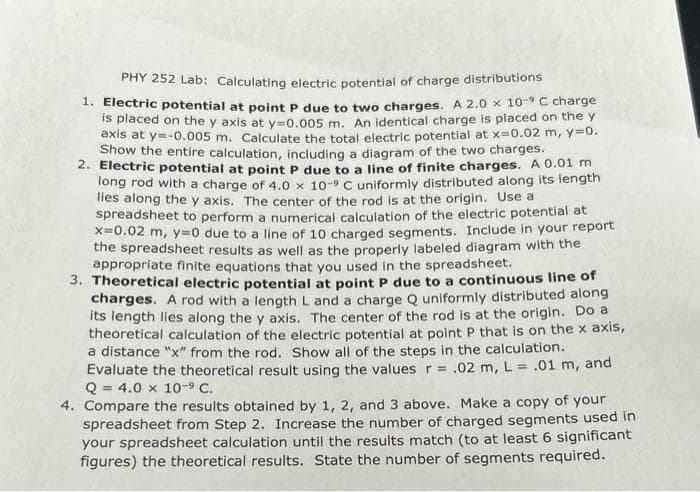1. Electric potential at point P due to two charges. A 2.0 x 10-9 C charge is placed on the y axis at y=0.005 m. An identical charge is placed on the y axis at y=-0.005 m. Calculate the total electric potential at x=0.02 m, y=0. Show the entire calculation, including a diagram of the two charges.
1. Electric potential at point P due to two charges. A 2.0 x 10-9 C charge is placed on the y axis at y=0.005 m. An identical charge is placed on the y axis at y=-0.005 m. Calculate the total electric potential at x=0.02 m, y=0. Show the entire calculation, including a diagram of the two charges.
College Physics
10th Edition
ISBN:9781285737027
Author:Raymond A. Serway, Chris Vuille
Publisher:Raymond A. Serway, Chris Vuille
Chapter16: Electrical Energy And Capacitance
Section: Chapter Questions
Problem 18P: A positive point charge q = +2.50 nC is located at x = 1.20 m and a negative charge of 2q = 5.00 nC...
Related questions
Question

Transcribed Image Text:PHY 252 Lab: Calculating electric potential of charge distributions
1. Electric potential at point P due to two charges. A 2.0 x 10-⁹ C charge
is placed on the y axis at y=0.005 m. An identical charge is placed on the y
axis at y=-0.005 m. Calculate the total electric potential at x=0.02 m, y=0.
Show the entire calculation, including a diagram of the two charges.
2. Electric potential at point P due to a line of finite charges. A 0.01 m
long rod with a charge of 4.0 x 10-9 C uniformly distributed along its length
lies along the y axis. The center of the rod is at the origin. Use a
spreadsheet to perform a numerical calculation of the electric potential at
x=0.02 m, y=0 due to a line of 10 charged segments. Include in your report
the spreadsheet results as well as the properly labeled diagram with the
appropriate finite equations that you used in the spreadsheet.
3. Theoretical electric potential at point P due to a continuous line of
charges. A rod with a length L and a charge Q uniformly distributed along
its length lies along the y axis. The center of the rod is at the origin. Do a
theoretical calculation of the electric potential at point P that is on the x axis,
a distance "x" from the rod. Show all of the steps in the calculation.
Evaluate the theoretical result using the values r= .02 m, L = .01 m, and
Q = 4.0 x 10-⁹ C.
4. Compare the results obtained by 1, 2, and 3 above. Make a copy of your
spreadsheet from Step 2. Increase the number of charged segments used in
your spreadsheet calculation until the results match (to at least 6 significant
figures) the theoretical results. State the number of segments required.
Expert Solution
This question has been solved!
Explore an expertly crafted, step-by-step solution for a thorough understanding of key concepts.
Step by step
Solved in 2 steps with 2 images

Knowledge Booster
Learn more about
Need a deep-dive on the concept behind this application? Look no further. Learn more about this topic, physics and related others by exploring similar questions and additional content below.Recommended textbooks for you

College Physics
Physics
ISBN:
9781285737027
Author:
Raymond A. Serway, Chris Vuille
Publisher:
Cengage Learning

Physics for Scientists and Engineers, Technology …
Physics
ISBN:
9781305116399
Author:
Raymond A. Serway, John W. Jewett
Publisher:
Cengage Learning

Principles of Physics: A Calculus-Based Text
Physics
ISBN:
9781133104261
Author:
Raymond A. Serway, John W. Jewett
Publisher:
Cengage Learning

College Physics
Physics
ISBN:
9781285737027
Author:
Raymond A. Serway, Chris Vuille
Publisher:
Cengage Learning

Physics for Scientists and Engineers, Technology …
Physics
ISBN:
9781305116399
Author:
Raymond A. Serway, John W. Jewett
Publisher:
Cengage Learning

Principles of Physics: A Calculus-Based Text
Physics
ISBN:
9781133104261
Author:
Raymond A. Serway, John W. Jewett
Publisher:
Cengage Learning

College Physics
Physics
ISBN:
9781305952300
Author:
Raymond A. Serway, Chris Vuille
Publisher:
Cengage Learning


Physics for Scientists and Engineers: Foundations…
Physics
ISBN:
9781133939146
Author:
Katz, Debora M.
Publisher:
Cengage Learning